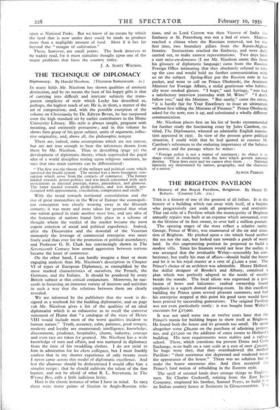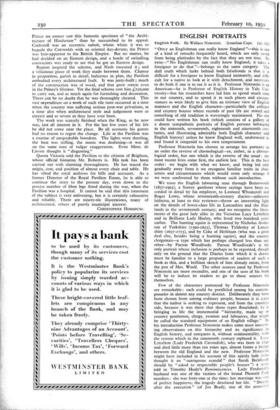THE BRIGHTON PAVILION
A History of the Royal Pavilion, Brighton. By Henry D. Roberts. (Country Life. zrs.) Tins is a history of one of the greatest of all follies. It is the history of a building which ran away with itself, of a builder who progressively cast aside all proportions and restraints. That sad relic of a Pavilion which the municipality of Brighton annually repairs was built at an expense which amounted, even in the lifetime of its first owner, to over half a million pounds.
The opening stages of the story reflect a relative sanity. George, Prince of Wales, was enamoured of the air and situa- tion of Brighton. He pitched upon a site which faced neither the sea nor the sun, but looked east towards a patch of waste land. In this unpromising position he proposed to build a modest villa. Since his finances would not bear the outlay, it was arranged that the invaluable Weltje—ostensibly his con- fectioner, but really his man of affairs—should build the house and let it to his royal master at a rent of £1,000 a year. The Prince's choice of an architect was admirable. Henry Holland, the skilful designer of Brooks's and Albany, contrived a plan which was perfectly adapted to the needs of royalty beside the seaside. The local idiom was expressed in a pro- fusion of bows and balconies : exalted ownership found emphasis in a superb domed drawing-room. In this excellent building the Prince spent several pleasant summers; and had his enterprise stopped at this point his good taste would have been praised by succeeding generations. The original Pavilion was not even particularly costly : it was bought from Weltje's executors for £17,000.
It was not until some ten or twelve years later that the Prince's mania for building began to show itself at Brighton. He found both the house and its grounds too small. He spent altogether some £8o,00o on the purchase of adjoining proper- ties, and £27,000 on the addition of extra rooms to Holland s building. His next requirements were stables and a riding- school. These, which constitute the present Dome and Corn Exchange, were built on a vast scale at a cost of over £50,000. So huge were they, that they overshadowed the modest Pavilion : "their enormous size depressed and rendered mean the appearance of the house." There was no solution but to make the house enormous also. And then occurred the Prince's fatal notion of rebuilding in the Eastern style.
The spell of oriental lands does strange things to Englis men. Sir Charles Cockerell, retiring from the East India Company, employed his brother, Samuel Pepys, to build tyro an Indian country house at Sezincote in Gloucestershire. The
Prince no sooner saw this fantastic specimen of "the Archi- tecture of Hindustan" than he succumbed to its appeal. Cockerell was an eccentric nabob, whose whim it was to beguile the Cotswolds with an oriental day-dream; the Prince was heir-apparent to the British Empire. But no matter, he had decided on an Eastern design, and a horde of swindling contractors was ready to see that he got an Eastern design.
Repton inspired the scheme, and Nash executed it ; and a villainous piece of work they made between them. Clumsy in proportion, garish in detail, ludicrous in plan, the Pavilion embodied every architectural fault. It was jerry-built ; much of the construction was of wood, and that grew rotten even in the Prince's lifetime. Yet the final scheme cost him L150,000 to carry out, and as much again for furnishing and decoration. There can be no doubt that he was thoroughly cheated. This vast expenditure on a work of such vile taste occurred at a time when the country was suffering serious post-war privations, at a time also when architectural style and judgement were as correct and as severe as they have ever been.
The work was scarcely finished when the King, as he now was, lost all interest in it. For the last few years of his life he did not come near the place. By all accounts his guests had no reason to regret the change. Life at the Pavilion was a routine of unspeakable boredom. The lights were dazzling, the heat was stiffing, the music was deafening—it was all on the same note of vulgar exaggeration. Even Mme. de Lieven thought it "disgusting."
Queen Victoria sold the Pavilion to the citizens of Brighton, whose official historian Mr. Roberts is. His task has been carried out with alarming thoroughness. He has traced the origin, cost, and position of almost every chair and table. He has sifted the royal archives for bills and accounts. As a former Director of the Royal Pavilion Estate, he is able to continue the story to the present day, even down to the precise number of fibre legs fitted during the war, when the Pavilion was a hospital. It cannot be said that this treatment of the subject is very enlivening, but it is certainly exhaustive and reliable. There are ninety-six illustrations, many of architectural, others of purely municipal interest.
CHRISTOPHER HOBHOUSE.















































 Previous page
Previous page